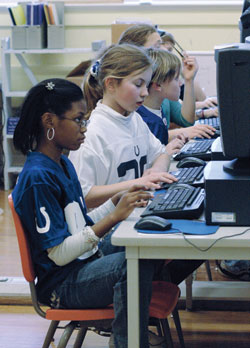St. Joan of Arc’s resurrection leads to national recognition

St. Joan of Arc School fifth-grade students Jaela Payne, from left, Mary Cate Pachciarz and Sam Osborn place their Accelerated Reader (AR) data onto a Microsoft Excel spreadsheet during a technology class on Jan. 11 at the Indianapolis North Deanery grade school. This project helps them track their overall progress, view their reading comprehension success and learn how to analyze the data. (Photo by Mary Ann Wyand)
By Mary Ann Wyand
Embracing and celebrating diversity helped St. Joan of Arc Parish and School in Indianapolis earn national recognition last month.
Father Guy Roberts, administrator, and Mary Pat Sharpe, principal, accepted a Catholic Identity Award from William H. Sadlier Inc. and the Archdiocese of Indianapolis during the National Catholic Educational Association convention on March 25 at the Indiana Convention Center in Indianapolis.
Presented on Easter Tuesday, the award for “shaping Catholic identity in the Church’s life, faith and mission through the various ministries of Catholic education” symbolizes a resurrection of new life at the multicultural school on the near north side, which struggled with declining enrollment and low standardized test scores of students for years.
To help address these challenges, parish and school officials invited Eileen Gale Kugler, the author of Debunking the Middle-Class Myth: Why Diverse Schools Are Good for All Kids, to speak during an Indianapolis North Deanery program in 2007 at St. Joan of Arc Church as part of Catholic Schools Week activities.
Kugler’s book was inspired by the benefits of attending Annandale High School in Fairfax County, Va., one of the most diverse public high schools in the U.S. due to the “broad mix of racial, ethnic and socioeconomic backgrounds” of students.
During the program, Kugler shared stories from her research at diverse schools across the U.S. about the merits of growing up and learning with students from other countries and cultures.
“Learning comes alive when wisdom is shared not only by competent teachers and textbooks,” she noted, “but also by fellow students with life experiences and cultures that illuminate whole new worlds.”
Diversity enables educators to achieve extraordinary things in the classroom, she said, with the “wealth of information” from interaction by multicultural students.
“When you have students who are from different backgrounds [in class together], it opens the world to them,” Kugler said. “Kids start thinking differently. … They stop thinking there is only one right way, only one answer to a problem. They become critical thinkers. They become problem-solvers. … They see wisdom in lots of places.”
Kugler’s book emphasizes that “a diverse school that is well run and supported by the community is an academic and social gold mine [that] provides … [world-class] education that our students and our greater society need.”
Myths about education include the mistaken belief that the best schools have the highest standardized test scores, she said, and the misguided perceptions that diverse schools aren’t safe and can’t provide rigorous curriculum for students.
Diverse schools teach students to respect and celebrate each others’ cultures, Kugler said, by building character and friendship among youths through the arts and assignments that provide opportunities to express ideas.
Father Roberts said parish and school staff members try “to make a Catholic education relevant in the 21st century in our circumstances here with the demographics that we’re serving.”
Staff members focus on “thinking outside the box,” he said, to better minister to the school’s 171 students. About 54 percent of the students are black and about 60 percent are non-Catholic.
“We’re trying to introduce students to more technology,” Father Roberts said. “We also have a vocational piece to introduce the students to careers and expand their horizons by visiting [area] businesses and universities to get them thinking about their futures.
“If they don’t know what’s out there, then they can’t begin to dream,” he said. “We’re trying to encourage them to dream and to be forward-looking, not only for this life but, of course, certainly the spiritual element is there. What I try to do with the students is get them to think about their personal vocation. ‘Why did God put you here and how are you best going to exercise that blossoming of your life in the context of the next 60 to 70 years?’ ”
Mary Pat Sharpe, principal, said during the past five years of her leadership the students have moved from 57 percent passing the ISTEP (Indiana Standard Testing for Educational Progress) to 86 percent passing the proficiency test.
In addition to building school enrollment and improving academic standards, Sharpe said, St. Joan of Arc staff members regularly welcome non-Catholic students into the Church.
“Our mission as a Catholic Church is to be open and respectful to everyone,” she said. “That’s what we’re called to do. … It’s a very diverse environment here, and there is much respect and appreciation for everyone.” †
